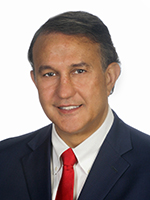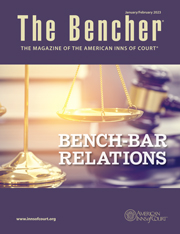Court Rejects Disqualification of Law Firm Based on Rules 1.9 and 1.10
The Bencher | January/February 2023
By Francis G.X. Pileggi, Esquire

 The U.S. Court of Appeals for the Third Circuit recently addressed a motion to disqualify based on a partner who moved from a law firm representing one party in a bankruptcy proceeding to the firm representing the opposing party in the same case. The court applied Model Rules of Professional Conduct 1.9 and 1.10(a)(2). The attorney who made the lateral move was described in the opinion as Jessica Lauria, née Boelter. (“Boelter”).
The U.S. Court of Appeals for the Third Circuit recently addressed a motion to disqualify based on a partner who moved from a law firm representing one party in a bankruptcy proceeding to the firm representing the opposing party in the same case. The court applied Model Rules of Professional Conduct 1.9 and 1.10(a)(2). The attorney who made the lateral move was described in the opinion as Jessica Lauria, née Boelter. (“Boelter”).
Rule 1.10(a)(2) imputes her conflict to her new firm unless she, among other things, “is timely screened from any participation in the matter and is apportioned no part of the fee therefrom.” The new firm timely screened Boelter, but Boelter’s former client moved to disqualify her new firm, White & Case, arguing that a screen was not enough. The appeal considers the decision of the U.S. Bankruptcy Court, which denied a motion to disqualify White & Case.
The underlying case involved the Chapter 11 bankruptcy of Maxus Energy Corporation. In 2018, Maxus Liquidating Trust (“Trust”) sued the parent companies of Maxus, YPF S.A., YPF International S.A., YPF Holdings Inc., and CLH Holdings Inc. (collectively, “YPF”). White & Case represented the Trust, and Sidley Austin LLP represented YPF.
Boelter was a partner at Sidley and participated in Sidley’s initial pitch to represent YPF. She recorded a total of 300 hours in the representation of YPF, mostly at the beginning of the case. YPF executives regarded her as an integral part of their legal team.
Thomas Lauria, a partner at White & Case, did not record any time related to the case. Boelter started dating Lauria in 2017, before Boelter pitched Sidley to YPF. In late 2019, Boelter and Lauria began living together. Sidley knew of their relationship.
Boelter moved to White & Case while engaged to marry Lauria. At that time, White & Case followed the applicable Model Rules of Professional Conduct, and Boelter followed the standard conflict-screening process. White & Case implemented an ethical wall that the parties agreed qualified as a screen, beginning on Boelter’s first day. Her new firm obtained her acknowledgement that she complied with the screen and periodically certified her compliance. Her new firm did not give any portion of its fee from the YPF adversary proceeding to Boelter. White & Case gave YPF written notice of Boelter’s employment the day she began with the firm, explained the nature of White & Case’s screen, and included the statement of the firm’s and Boelter’s compliance with the Model Rules. White & Case stated that review may be available before a tribunal, and the firm agreed to respond promptly to any written inquiries or objections about the screening procedures.
YPF moved to disqualify based on its view that no screen would be satisfactory. The Third Circuit accepted appellate review. The standard of review for interpretation of the Model Rules, as a question of law, was de novo. The bankruptcy court’s denial of disqualification was treated as a sanction for which the standard of appellate review is abuse of discretion.
Model Rule 1.9 prohibits a lawyer who has formerly represented a client in a matter from “representing another person in the same or substantially related matter in which the person’s interests are materially adverse to the interests of the former client.” Both parties agree that Boelter did not try to participate in White & Case’s representation of the Trust.
Model Rule 1.10(a), however, states that no lawyer at a firm “shall knowingly represent a client when any one of them practicing alone would be prohibited from doing so by Rules 1 .7 or 1.9,” unless certain conditions subsequent are satisfied. Those subparagraphs that provide an exception to Rule 1.10(a) are contained in Rule 1.10(a)(2) and require the disqualified lawyer to be timely screened from any participation in the matter and apportioned no part of the fee therefrom. It also requires a written notice to be promptly given to any affected former client along with a statement of the firm’s and the screened lawyer’s compliance with the rules, as well as a statement that review may be available before a tribunal. The firm must agree to respond promptly to any written inquiries or objections by the former client about the screening procedures. The third condition subsequent in Rule 1.10(a)(2) requires certifications of compliance with the rules and with the screening procedures to be provided to the former client by the screened lawyer and by a partner of the firm at reasonable intervals upon the former client’s written request and upon termination of the screening procedures.
Compliance with these conditions subsequent relieves the preceding duty, and if the firm adheres to screening of the disqualified attorney, allocating no part of the fee from the conflicted representation, and follows the other procedures in Model Rule 1.10(a)(2), the disqualified attorney’s conflict cannot be imputed to the entire firm.
The court regarded the Model Rule as sufficient for its analysis and declined to follow the application by the bankruptcy court of an “exceptional circumstances” exception as well as a multifactor test that was based on a decision by the District of Delaware.
The court of appeals observed that whether a firm’s conflict-of-interest procedures qualify as a screen under Model Rule 1.0(k) is a separate analysis. Model Rule 1.0(k) defines a screen as “the isolation of a lawyer from any participation in a matter with a timely imposition of procedures within a firm that are reasonably adequate under the circumstances to protect information that the isolated lawyer is obligated to protect under these Rules or other law.” Courts determine based on the facts of each case whether a firm’s conflict-of-interest procedures qualify as an effective screen.
The court reasoned that Rule 1.10(a)(2)(i) only requires that the otherwise “disqualified lawyer” must “be apportioned no part of the fee” from the matter, but this restriction does not apply to her spouse or other lawyers not disqualified.
The court of appeals held that White & Case complied with Model Rule 1.10(a)(2) and that the bankruptcy court did not abuse its discretion in reaching the same conclusion that the firm was not disqualified from representing the Trust. The bankruptcy court found that the ethical screen implemented by White & Case was thorough and robust between Boelter and the YPF adversary proceeding. Nor does YPF dispute that Boelter did not receive any part of the fees from White & Case’s representation of YPF.
The bankruptcy court also found that White & Case gave YPF prompt notice of the screening procedures, as well as repeated statements that White & Case and Boelter would comply with the screening procedures. White & Case also confirmed that it would respond promptly to any inquiries from YPF about the screen and invited YPF to provide input. White & Case further confirmed that review may be available before a tribunal and that White & Case and Boelter complied to the letter with the applicable ethical rule.
As a general reference, it should be noted in passing, that at least in Delaware, courts are cautious about taking the weighty step of disqualifying a lawyer of a party’s choice at the behest of his litigation adversary. See In Re: Straight Path Commc’ns Inc. S’holder Litig., Consol. C.A. No. 2017 – 0486 – SG, Slip op. at n.33 (Del. Ch. August 25, 2022.) Nonetheless, the court has the inherent authority to raise the issue ex mero motu, if necessary, to ensure the integrity of the adversary process and the fairness of the proceedings. Id. at n. 22 (noting this authority in the context of the application of Rule of Professional Conduct 3.7(a) to an attorney serving as counsel for party and a potential fact witness at trial.)
Francis G.X. Pileggi, Esquire, is a managing partner of the Delaware office of Lewis Brisbois Bisgaard & Smith, LLP. He comments on key corporate and commercial decisions as well as legal ethics topics at www.DelawareLitigation.com.